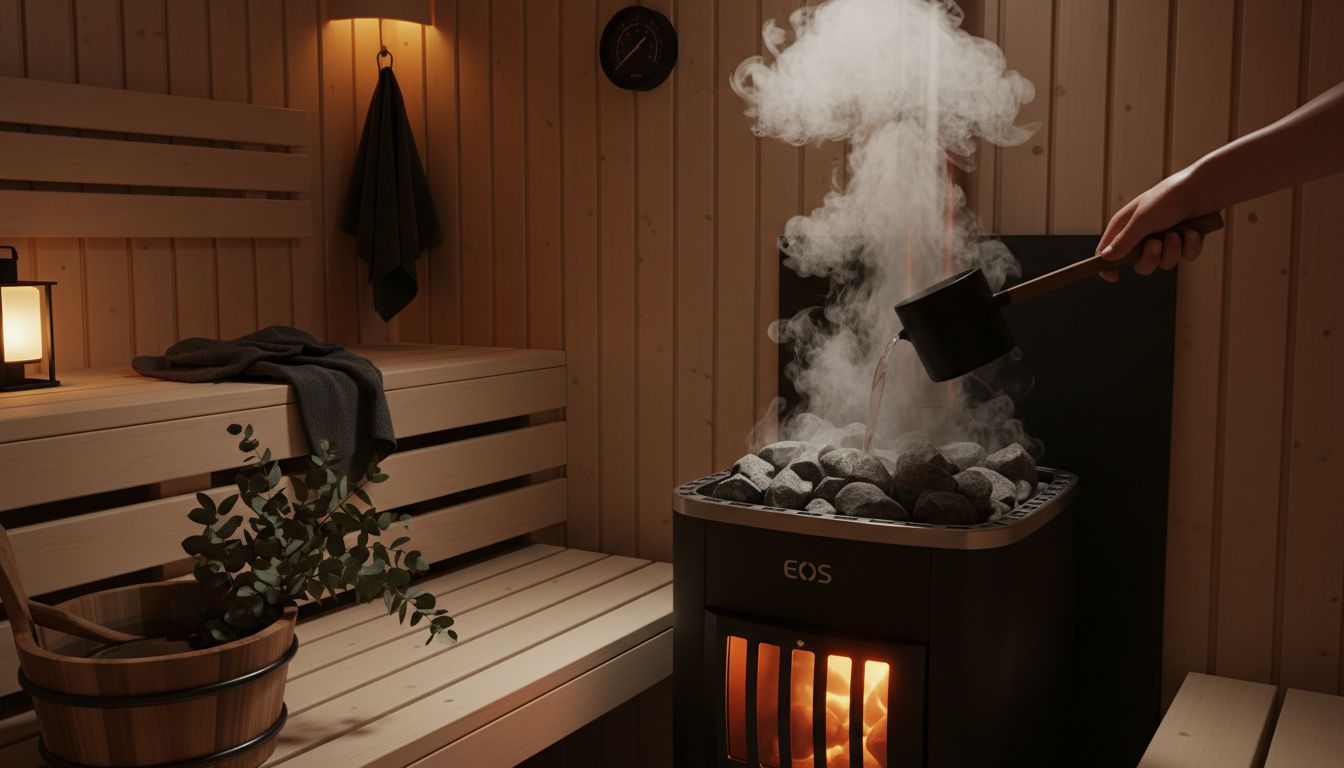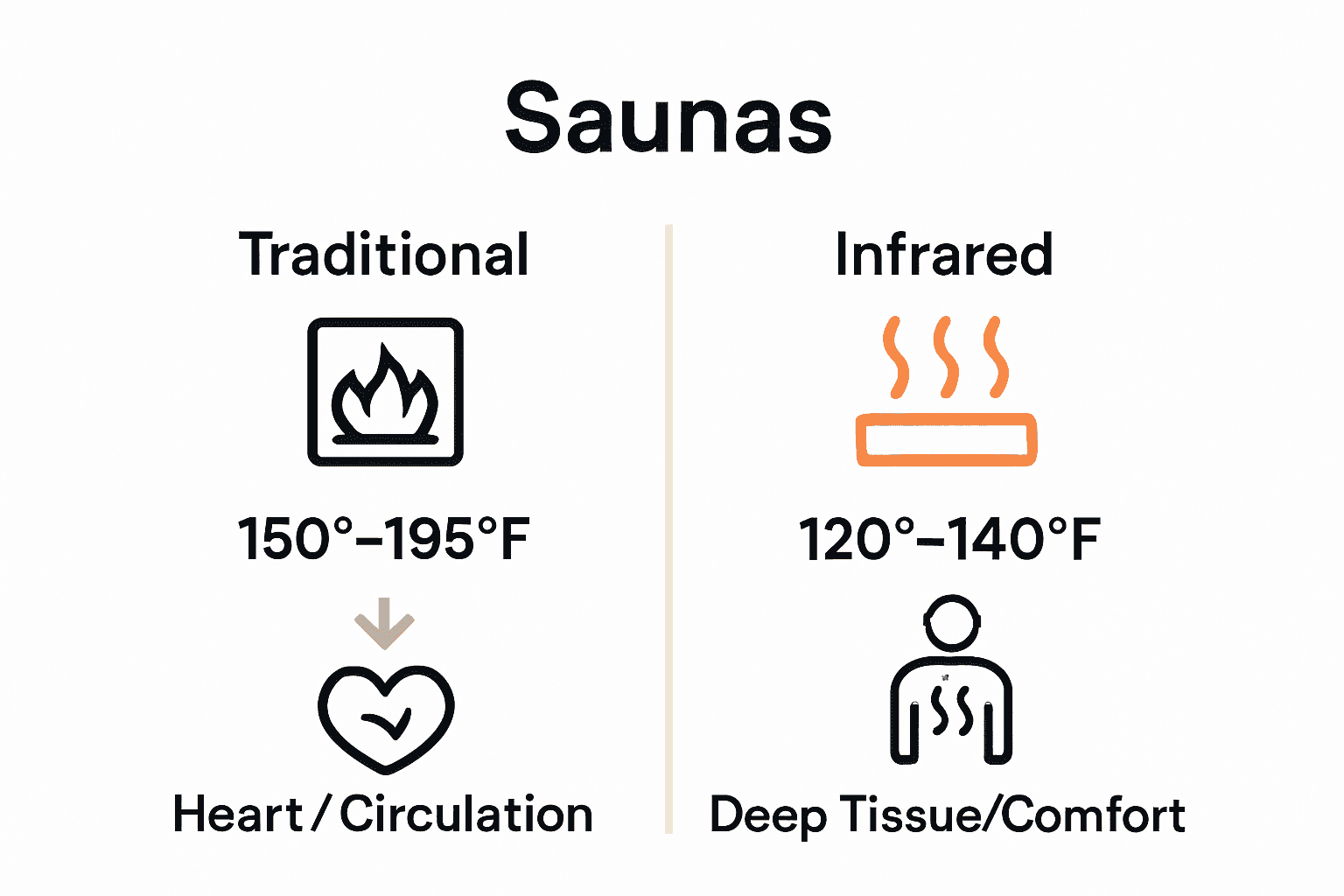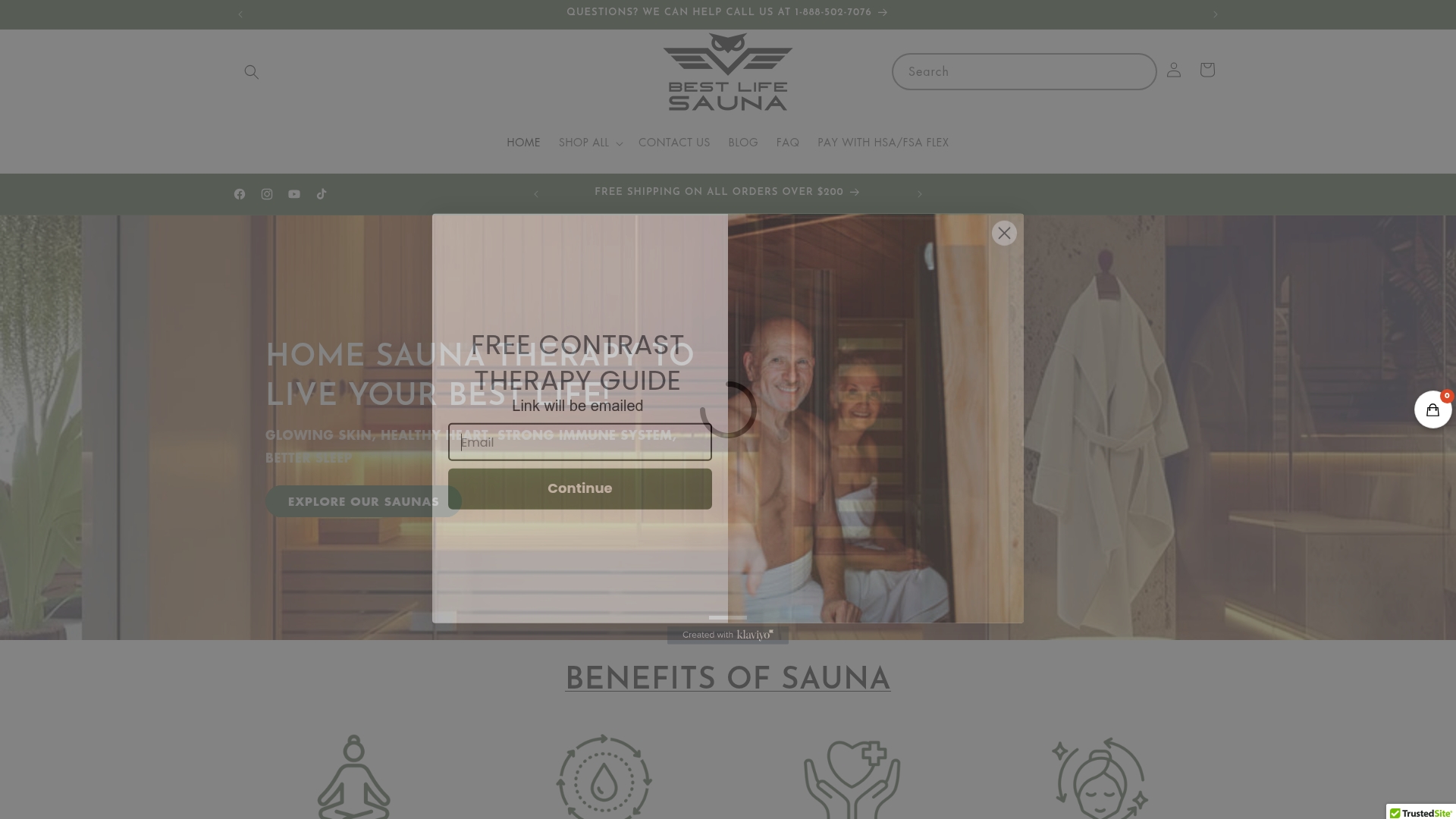
Why Sauna Usage Is Popular: Complete Guide
Stepping into a sauna offers more than just a soothing escape. Scientists have found that regular sauna sessions at temperatures between 45 and 100 degrees Celsius can trigger remarkable changes inside the body. With evidence linking these ancient rituals to better heart health, sharper mental clarity, and even lower stress, the growing popularity of sauna use is easy to understand. This guide breaks down the different types, health benefits, practical tips, and the smart way to weave sauna therapy into modern wellness routines.
Table of Contents
- Defining Sauna Usage And Its Appeal
- Types Of Saunas And Core Differences
- Health Benefits Driving Sauna Popularity
- Wellness Trends And Lifestyle Integration
- Safety, Risks, And Smart Usage Tips
Key Takeaways
| Point | Details |
|---|---|
| Holistic Health Benefits | Regular sauna use improves cardiovascular health, enhances mental wellness, and aids in metabolic optimization. |
| Diverse Sauna Types | Saunas vary in heating methods and environments, including traditional wood-burning, electric, and infrared, catering to personal preferences. |
| Integration into Wellness Routines | Saunas are increasingly incorporated into holistic health practices, serving as tools for physical recovery and stress management. |
| Safety Precautions | Proper hydration and time management are essential for safe sauna experiences; individuals with health concerns should consult professionals before use. |
Defining Sauna Usage and Its Appeal
Sauna usage is a centuries-old wellness practice involving deliberate exposure to intense heat environments designed to trigger profound physiological responses. According to PubMed, sauna bathing involves short-term heat exposure ranging between 45°C to 100°C, which induces mild hyperthermia and activates complex thermoregulatory mechanisms within the human body.
The appeal of sauna usage extends far beyond simple relaxation. As research from Stanford Lifestyle Medicine suggests, regular sauna sessions offer multifaceted health benefits across several critical domains:
- Cardiovascular Health: Improved heart function and circulation
- Neurological Wellness: Enhanced brain performance and stress reduction
- Metabolic Optimization: Potential support for metabolic processes and weight management
When individuals step into a sauna, they’re not just experiencing heat. They’re engaging in a deliberate wellness practice that challenges the body’s adaptive mechanisms. The controlled thermal stress triggers sweating, increases heart rate, and stimulates circulation much like moderate exercise. These physiological responses contribute to the growing popularity of sauna usage among health-conscious individuals seeking holistic approaches to personal wellness and recovery.
Moreover, the psychological benefits cannot be overlooked. The meditative environment of a sauna provides a unique opportunity for mental reset. Users often report feeling refreshed, relaxed, and mentally clear after a session, highlighting that sauna usage is as much a mental health practice as a physical one. Whether used for post-workout recovery, stress management, or general well-being, saunas represent a powerful intersection of ancient wellness traditions and modern health optimization strategies.
Types of Saunas and Core Differences
Sauna types represent a diverse world of heat therapy, each offering unique experiences and health benefits. According to Sauna Society, saunas can be categorized into several distinct styles, including traditional Finnish saunas, dry saunas, steam baths, and modern infrared variants. Each type creates a unique thermal environment designed to promote wellness through different heating mechanisms.

As detailed by Cleveland Clinic Health, traditional saunas typically operate at high temperatures ranging from 150°F to 195°F, characterized by low humidity levels. These saunas can be further classified into two primary heating methods:
- Wood-Burning Saunas: Classic Finnish-style heating using wood stoves
- Electric Saunas: Modern installations using electrical heating elements
Infrared saunas represent a technological evolution in heat therapy. Unlike traditional models, these innovative spaces use infrared lamps to create heat at lower temperatures between 110°F and 135°F. This approach allows for deeper tissue penetration with less environmental heat, making them appealing to individuals who find traditional high-temperature environments uncomfortable.
The core difference between sauna types lies in their heating mechanisms and thermal characteristics. Traditional saunas create heat by warming the air around the body, causing immediate surface-level sweating. Infrared saunas, conversely, directly warm body tissues, creating a more targeted and potentially more comfortable heating experience. This nuanced approach means different sauna types can cater to varied personal preferences, fitness goals, and individual physiological responses to heat exposure.

Health Benefits Driving Sauna Popularity
Sauna usage has rapidly gained popularity as a holistic wellness practice with profound physiological benefits. According to PubMed, regular sauna sessions trigger remarkable cardiovascular responses that closely mirror those experienced during aerobic exercise, positioning heat therapy as a potent wellness strategy.
Research from DOAJ highlights multiple compelling health benefits that are driving widespread sauna adoption:
- Cardiovascular Health: Reduced risks of hypertension and coronary artery disease
- Mental Wellness: Significant stress and anxiety reduction
- Physiological Adaptation: Enhanced cardiovascular performance
Beyond the documented medical benefits, sauna usage represents a comprehensive approach to body and mind restoration. The controlled heat exposure stimulates multiple physiological mechanisms, including improved blood circulation, enhanced metabolic processes, and accelerated cellular repair. Users experience a profound sense of relaxation as their body undergoes complex thermoregulatory responses, releasing tension and promoting overall well-being.
The mental health dimensions of sauna use are equally compelling. The meditative environment, combined with intense yet controlled heat, creates a unique therapeutic experience. Regular sauna sessions have been associated with improved mood regulation, reduced cortisol levels, and a significant decrease in stress-related symptoms. This holistic impact on both physical and psychological health explains why an increasing number of health-conscious individuals are incorporating sauna sessions into their wellness routines.
Wellness Trends and Lifestyle Integration
Sauna practices have transcended traditional recreational activities, emerging as a strategic wellness intervention. According to PubMed, sauna use represents a sophisticated lifestyle approach aimed at extending healthspan, with compelling evidence suggesting dose-dependent links between regular thermal exposure and reduced morbidity and mortality.
Stanford Lifestyle Medicine highlights how sauna bathing is being systematically integrated into holistic wellness routines, offering comprehensive health benefits across multiple domains:
- Physical Recovery: Supporting muscle relaxation and post-exercise restoration
- Stress Management: Creating deliberate spaces for mental decompression
- Preventative Health: Proactively supporting cardiovascular and metabolic functions
The contemporary wellness landscape increasingly views saunas not as luxury amenities, but as intentional health optimization tools. Modern practitioners are strategically incorporating heat therapy into comprehensive wellness protocols, often combining sauna sessions with complementary practices like meditation, hydration strategies, and targeted nutritional support. This integrated approach transforms sauna use from a passive experience into an active, purposeful component of personal health management.
Moreover, the rising popularity of sauna practices reflects a broader cultural shift toward proactive, holistic wellness. Individuals are no longer satisfied with reactive healthcare models, instead seeking evidence-based interventions that promote long-term physiological resilience. Saunas represent this philosophy perfectly: a practice rooted in ancient traditions yet validated by contemporary scientific research, offering a tangible method for individuals to take meaningful control of their health and well-being.
Safety, Risks, and Smart Usage Tips
Sauna safety demands a thoughtful and informed approach to heat therapy. According to DOAJ, while sauna bathing offers substantial health benefits, potential risks include dehydration and complications for individuals with specific health conditions, underscoring the importance of mindful usage.
Research from PubMed highlights critical duration management principles for safe sauna experiences:
- Time Limitation: Avoid continuous exposure exceeding 10 minutes
- Hydration: Drink water before and after sauna sessions
- Physical Awareness: Monitor body’s response to heat stress
Before engaging in sauna therapy, individuals should consult healthcare professionals, especially those with pre-existing cardiovascular conditions, pregnant women, or individuals with chronic health challenges. Certain medical conditions like uncontrolled hypertension, recent heart attack, or severe respiratory diseases might necessitate avoiding or modifying sauna usage.
Smart sauna practice involves more than just time management. Proper preparation includes staying well-hydrated, avoiding alcohol consumption, wearing minimal clothing to facilitate heat exchange, and listening to your body’s signals. Beginners should start with shorter, less intense sessions, gradually building heat tolerance. Always have a companion nearby, use clean towels, and maintain personal hygiene to maximize safety and enjoyment of this powerful wellness practice.
Elevate Your Wellness Journey with the Perfect Sauna Solution
Understanding the profound benefits of sauna use is just the first step toward transforming your health and well-being. Whether you are seeking to improve cardiovascular health, manage stress, or enhance recovery, selecting the right sauna tailored to your needs makes all the difference. At Best Life Sauna, we recognize the challenge of finding a sauna that fits your lifestyle and comfort preferences while delivering real wellness results.
Explore our diverse collection featuring infrared, traditional, and outdoor saunas that align with the latest research-backed practices on heat therapy. Our products are designed to support your body’s natural responses to heat, promote relaxation, and provide a mental reset after a busy day. Pair your sauna with essential accessories to optimize your sessions safely and effectively.
Discover the full range at Best Life Sauna and experience the difference a carefully chosen sauna can make in your daily routine. Visit our landing page now and take the next step toward your healthiest self.
Unlock these benefits with confidence and support.
Start your holistic wellness journey today.

Ready to embrace the proven advantages of sauna use Make your wellness a priority with Best Life Sauna’s premium products. Browse our selection and enjoy exclusive offers including free shipping on orders over $200 and a price match guarantee. Visit Best Life Sauna to transform your home wellness experience now.
Frequently Asked Questions
What are the health benefits of sauna usage?
Sauna usage offers various health benefits, including improved cardiovascular health, enhanced brain performance, support for metabolic processes, and significant stress reduction. Regular sessions may also help with muscle recovery and overall well-being.
How does an infrared sauna differ from a traditional sauna?
Infrared saunas use infrared lamps to directly warm body tissues at lower temperatures (between 110°F and 135°F), allowing for deeper tissue penetration. In contrast, traditional saunas heat the air around the body, typically operating at higher temperatures (150°F to 195°F) with lower humidity levels.
What should I consider for safe sauna use?
For safe sauna use, limit your exposure to no more than 10-15 minutes per session, stay well-hydrated before and after, and listen to your body’s signals. Individuals with specific health conditions should consult healthcare professionals before using a sauna.
How frequently should I use a sauna for health benefits?
For optimal health benefits, using a sauna 2 to 3 times a week is often recommended. Regular sessions can enhance cardiovascular performance and overall wellness, but be sure to listen to your body and adjust frequency as needed.

